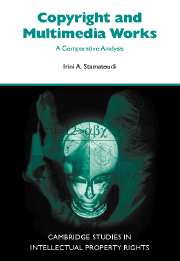Book contents
- Frontmatter
- Contents
- Acknowledgments
- List of abbreviations
- Introduction
- 1 Placing multimedia products within the scope of copyright
- 2 The scope of multimedia works
- 3 Traditional literary works
- 4 Collections and compilations
- 5 Databases
- 6 Audiovisual works
- 7 Computer programs
- 8 Video games as a test case
- 9 Multimedia products and existing categories of copyright works
- 10 A regime of protection for multimedia products
- 11 Conclusions
- Postscript
- Bibliography
- Index
2 - The scope of multimedia works
Published online by Cambridge University Press: 25 July 2009
- Frontmatter
- Contents
- Acknowledgments
- List of abbreviations
- Introduction
- 1 Placing multimedia products within the scope of copyright
- 2 The scope of multimedia works
- 3 Traditional literary works
- 4 Collections and compilations
- 5 Databases
- 6 Audiovisual works
- 7 Computer programs
- 8 Video games as a test case
- 9 Multimedia products and existing categories of copyright works
- 10 A regime of protection for multimedia products
- 11 Conclusions
- Postscript
- Bibliography
- Index
Summary
DEFINITION OF MULTIMEDIA WORKS
As previously mentioned, multimedia means many different things to different people. For example, it can mean enterprises, types of communication, products or services. It is rather an amorphous term. People understand it as encompassing interactive television, interactive guides in museums, product catalogues in electronic malls, schedules in train stations, on-line databases which can be retrieved worldwide from networks such as the Internet in the form of virtual reality, simple video, computer games, and so on.
As we will see in more detail later on, all these products share characteristics that come within the definition of multimedia products and therefore belong to the same generation. However, they are also somewhat different from one another by reason of the particularities they present and the different purposes and functions they serve. The large and vague variety of products that exists in the market constitutes the reason why multimedia is more of a phenomenon than a product which can be pinned down to certain particular functions and characteristics, remaining stable over several years.
Because multimedia is a comparatively new term, inextricably linked with technology and its progress, it is also a fast-evolving term, which inevitably brings with it the characteristics of every new term: broadness and ambiguity. Broadness has a positive connotation in so far as it signifies the capacity multimedia has to accommodate a vast range of things. Ambiguity has a negative connotation in so far as it signifies a reservation as to what it finally accommodates.
- Type
- Chapter
- Information
- Copyright and Multimedia ProductsA Comparative Analysis, pp. 16 - 41Publisher: Cambridge University PressPrint publication year: 2001



